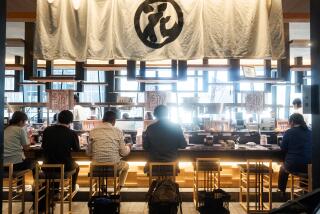Ford Bronco Lands on Its Feet
- Share via
DETROIT — Last summer, a consumer group blasted the safety record of the Suzuki Samurai, and the press--and the car-buying public--gasped.
It was big news.
So big that Suzuki still hasn’t recovered.
“Suzuki got powdered,” said John Merriam, publisher of Corporate Exposure, a newsletter that measures the impact of media coverage on corporations.
The negative publicity was so pervasive and so damaging that Suzuki’s once hot little utility vehicle has so far been unable to pull out of its ongoing dive--even though the federal government has since cleared the Samurai of the charges leveled last summer by the Consumers Union, publisher of Consumer Reports magazine.
Samurai sales are now at rock-bottom levels; Suzuki sold barely more than 1,000 in the first quarter, compared with more than 16,000 in the first three months of 1988.
By contrast, last month the federal government announced that a study of utility vehicles that it conducted following the Samurai controversy found that Ford’s popular Bronco II utility vehicle actually had a worse record than the Samurai on the one safety issue on which the Suzuki model had been indicted--the potential for rolling over during abrupt turns.
The National Highway Traffic Safety Administration also found that the Bronco II had actually suffered a higher rate of fatal roll-over accidents than any other vehicle in its class--including Samurai. Indeed, the government found that the Samurai was no worse than the average utility vehicle in its class.
But the press--and the car-buying public--yawned at the Bronco II news.
The story quickly died.
As a result, the federal report had virtually no impact on Bronco II sales, industry analysts and Ford dealers agree. Ford actually sold more Bronco IIs in March--the month the government made its announcement--than it did in February. Although Bronco II sales were down from a year ago, that decline is mostly due to an across-the-board decline in the entire car market, analysts say.
“They’re selling well,” said Jimmy Valentine, truck sales manager at Los Feliz Ford in Glendale. “I don’t think it (the government report) has hurt us at all.”
The reasons why Ford has dodged a bullet that so squarely hit Suzuki are certainly complex, but industry observers believe that one key factor has been the power of corporate image and reputation.
Ford, hugely profitable and on a roll, has built an extremely positive image for itself in the American mind, and thus can withstand negative news.
In fact, many observers believe that by the time the Bronco II story hit, Ford had developed a corporate version of Ronald Reagan’s Teflon image, and small batches of bad news simply couldn’t stick.
“I think Ford does have a Teflon image,” said Thomas O’Grady, president of Integrated Automotive Resources, a Wayne, Pa., automotive market research firm.
Merriam of Corporate Exposure adds that he believes that Ford has successfully used its remarkable financial turnaround and record profits as the basis on which to create a more positive public perception of the corporation generally. “Ford has done a good job of taking its good economic news and spreading that across the board,” Merriam said. “The fact that the company is making money tends to make the public think that it must be a good company and must make good products, too.”
“There is no question that Ford’s image is extremely strong right now,” added William Pochiluk, founder of Autofacts, a Paoli, Pa., research firm. “Ford is a big, full-line company, so you would expect this to have less of an impact than it did on a small company like Suzuki.”
Yet while Ford had a positive image, Suzuki had no image. The Japanese company, better known here for its motorcycles than its cars, had not yet become a household word in the car market by the time that the roll-over stories hit.
Initial Perception
For many consumers, the Samurai roll-over story was the first time that they had even heard of Suzuki. Those stories thus helped form the public’s initial perception of Suzuki and so had a much bigger impact than the Bronco II stories, industry observers believe.
“Nobody knew what the Samurai was, so the first news they heard about it was bad news,” one Ford official said. “Suzuki got hit in the head just as it was getting its legs.”
Suzuki officials argue, however, that corporate image wasn’t as important as the role played by the media in the Suzuki and Ford stories.
Indeed, it is fair to say that the Bronco II case received almost no notice in the national press or on the television networks; the Los Angeles Times was one of the few newspapers to give the story prominent play. By contrast, the Samurai roll-over controversy quickly gained momentum and became one of last summer’s biggest consumer stories.
Ron Rogers, public relations adviser to Suzuki, blames the inconsistent coverage of Suzuki and Ford on the press’ tendency to accept the word of a consumer group like Consumers Union over that of a corporation or even the federal government on product matters.
Rebuttals Discounted
“A consumer group has more credibility in the public’s mind than the government,” Rogers said. “And the press just accepted what the Consumers Union was saying (about the Samurai) as gospel,” while discounting Suzuki’s rebuttals, he added.
Perhaps most damaging, Rogers believes, was the role that television news played in the Samurai story. The Consumers Union released videotape of Samurais rolling over, tape that was played constantly on the news. By contrast, the federal government didn’t release any footage when it made its Bronco II announcement, and the story received scant notice on television.
“I think if a consumer group had held a press conference and shown videotape on the Bronco II, it would have had a big impact on Ford, too,” Rogers said.
Ford got a break, Rogers added, because of “a lack of film footage and a consumer group didn’t do it.”






